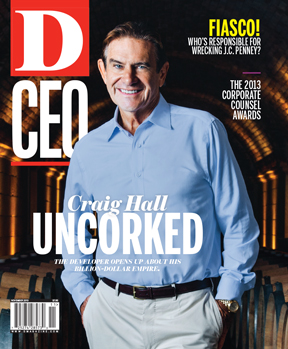John Crawford of Downtown Dallas Inc. stepped to the podium to warm up the crowd. About 150 business and civic leaders had gathered at the Meyerson Symphony Center to celebrate the mid-September groundbreaking of Craig Hall’s new Arts District office tower. The city’s biggest cheerleader ticked off a list of things that had happened downtown in recent years, despite the Great Recession: the convention center hotel, additional Arts District venues, Klyde Warren Park. “Hail to the Pegasus,” Crawford said. “Dallas is still a place where horses can fly.”
The city’s can-do spirit is precisely what lured Hall to Dallas from Michigan back in the early 1980s. Since then, the real estate developer and investor has experienced sensational highs and devastating lows—to the point of filing for bankruptcy. But Dallas also is a forgiving place. Perhaps it’s because of the region’s wildcatter culture, where plenty of dry holes are drilled in between the big plays. Or maybe it’s due to the collective misery felt during the real estate crash of the 1980s. Whatever the reason, failure isn’t necessarily a bad thing in Dallas. It just means you tried. Better luck next time.
And so here was Hall, on top of the world again, taking the stage to talk about his latest project, KPMG Plaza. The striking, 18-story, 500,000-square-foot building is the first to be constructed in downtown Dallas since One Arts Plaza broke ground in 2005. Along with Stephan Pyles’ flagship restaurant, it will house Hall Financial Group’s headquarters, KPMG, Jackson Walker, and UMB Bank. Two additional planned phases will take the project’s construction value up to about $750 million.
Although development was a long time coming—the land on which the tower will sit was purchased back in 1995—it’s another bold move for Hall, whose $1 billion-plus enterprise also includes Hall Office Park in Frisco, a financing company, an energy company, vineyards and wineries in California’s Napa Valley, and investments in myriad tech and health startups.
Not bad for someone who never wanted to get into business. “I grew up thinking that business was boring and kind of low-class,” says Hall. “It wasn’t contributing to society as much as being a professor or an accomplished scientist. To me, being out there grubbing for money didn’t seem the most noble thing to do.”
Instead, Hall thought he’d become a poet or a social worker. Or maybe he’d get into politics. More than anything, he wanted to make a difference. He wanted to matter.
• • •
Hall’s liberal sensibilities were cultivated in his hometown of Ann Arbor, Mich. The city was a hub for left-wing activism during the 1960s and 1970s, pioneering anti-discrimination policies and decriminalizing marijuana. Hall didn’t have an easy time of things as a kid. He had childhood epilepsy, which meant frequent seizures and heavy doses of the depressant Phenobarbital. This, in turn, led to struggles at school, where Hall was a loner. At home, an intense sibling rivalry with his older brother just made things worse. Hall would take off for the woods or write poetry to try to deal with it all. And he’d plot his future. “I wasn’t excelling at much of anything, but I still had big thoughts and big ideas,” he says. “I remember times when I’d be down and out and I’d think, ‘I’m going to show everybody. I’m going to have a successful life.’”

Some of his best times were game-day Saturdays at “The Big House,” where he and his brother joined 100,000 other fans to watch the University of Michigan Wolverines play football. Afterward they’d often stop off at a local drugstore for Green River sodas. When Hall learned the store was going out of business, he talked the owner into selling him the supplies used to make the drinks. Within a few months, Hall had turned a 50-cent investment into $37. But when he ran out of the syrup, his Green River enterprise was dead. A tough lesson for the budding entrepreneur, who was then 8 years old.
It was the start of a flurry of ventures for Hall. School was a hassle and he didn’t do well in sports—he broke his ankle on the first day of football practice and his nose on the first day of baseball practice. But he had a knack, he discovered, for making money. Instead of just one paper route, Hall had several. That led to a thriving lawn-care business that employed his brother and his brother’s friends. Hall lied about his age to sell knife sets door-to-door. Meantime, he also went to school and held down jobs ranging from dishwasher to night watchman.
At one point, Hall’s parents—his father was a businessman, his mother an art teacher—took him to a psychiatrist, concerned by what they viewed as their son’s obsession with money. “The tests were a joke,” he says. “I messed with the guy by telling him all the images looked like dollar bills. It was fun.”
During Hall’s senior year of high school, Ann Arbor was embroiled in a housing crisis that led to a citywide rent strike. There was a shortage of residences for students, so landlords could get away with charging outrageous rents and being lax about maintenance. According to the local tenants union, 90 percent of rental properties failed to meet city code. Charged up about the situation, Hall decided to take his life savings—$4,000—and buy a small rooming house. His goal was to prove that one could still make money by being a “good-guy” landlord, then get out. But the success of his first real estate project led to another. Eighteen-year-old Hall pulled together $200 from 15 different UofM students to help him make a second buy. It was the first of hundreds of limited partnerships that would ultimately help him raise more than $1 billion in equity. By his 21st birthday, Hall was a millionaire.
• • •
Hall segued from rooming houses into apartment complexes, upgrading the properties as he went, and moving his company from Ann Arbor to Southfield, a suburb of Detroit. He also diversified, getting into the racquetball-club business through a joint venture with Sports Illustrated and, of all things, helping to launch one of the country’s first for-profit health maintenance organizations. By the early 1980s, with his real estate holdings spread out across the United States, Hall went looking for a new home for his company’s headquarters. He narrowed the options to Atlanta, Phoenix, and Dallas. “It wasn’t a hard choice at all,” Hall says. “Dallas is a diverse, exciting place. Coming from the Midwest, everything seemed faster and better in Dallas. At the same time, the people here are incredible.”
The young entrepreneur was welcomed by the leadership class and forged friendships with real estate players who were much older than he was. In 1984 he joined Bum Bright in buying the Dallas Cowboys from Clint Murchison Jr. A year later, at the age of 35, Hall had 4,500 employees and $4 billion in assets, including 72,000 apartments, several million square feet of office space, and numerous other non-real estate businesses.

The Tax Reform Act of 1986 changed everything. With the tax shelters gone, investors and lenders wanted to pull out of the partnerships and began clamoring for their money. “Our whole business was changed, in an incredibly negative way, overnight,” says Don Braun, president of Hall Financial Group. “And it was not going to get better anytime soon. From 1986 to 1993 we just pretty much fixed problems.”
Hall liquidated his personal assets, including his stake in the Cowboys—anything that wasn’t real estate—to help cover debts. During the ensuing six years he tangled with a number of regulators and attorneys over the huge volume of loans. “There was a lot of blood on the table,” Hall says. The feds wanted to seize his assets through a law that had been enacted in the wake of the savings and loan crisis. To retain control, Hall filed for Chapter 11 bankruptcy protection in April 1992.
When the dust settled, the Resolution Trust Corp. offered a deal to sell Hall mortgages that some of his partnerships owed to S&Ls at a deep discount. To make it work, he had to come up with $102.5 million in 90 days—not an easy thing to do when you’ve just filed for personal bankruptcy. Still, Hall was able to leverage relationships and get the cash. And by 1993, he was back in the game.
The whole mess had publicly embarrassed Hall and tarnished his wunderkind reputation. Braun, though, considers it to be one of his boss’ finest moments. “Craig faced things straight on,” he says. “Getting through the debacle of the late 1980s and early 1990s, and the manner in which we did so, honestly, and holding our heads high—that’s what I’m most proud of.”
Not everyone was supportive, though. In a 2006 profile in D CEO, one industry player said, “There was a time I’d just as soon not be behind the wheel when Craig Hall was crossing the street.”
Longtime friend Herb Weitzman, chairman and CEO of The Weitzman Group, comes to Hall’s defense. “He did the right thing and honored his obligations. That wasn’t always the picture that was painted of him. … When you’re an aggressive entrepreneur, sometimes someone loses on the other side of the competition, and sometimes they say things that are trite.”
Hall had a special motivation for settling the bankruptcy in short order: He wanted to get married. He was introduced to Kathryn Walt through former Texas Gov. Ann Richards. An accomplished attorney and co-founder of the North Texas Food Bank, Walt was running for mayor of Dallas at the time (as Kathryn Cain, divorced from then-state senator David Cain). Hall invited her to have lunch at an Indian restaurant.
“It was unusual,” Kathryn says. “I loved Indian food, but I didn’t know many people in Texas who did. I thought he was great-looking, and he just seemed very open and easy to speak with.” By their second date, the couple knew they wanted to spend their lives together. “We both had a sense that this was meant to be,” Kathryn says. “It was so incredibly romantic—it still is, honestly.”
Today, 20 years later, the pain of the bad times and bankruptcy has greatly diminished. Hall, who’s now 63, has mellowed, too. Kathryn has made him a better person, he says, and he has gained confidence as a leader. Early on, he was insecure about not having an MBA or a master’s degree, and thought he had to be a more forceful manager. “I’m not nearly the jerk I used to be,” he says with a laugh. “In time, I learned that you could be a team-builder and succeed without being a harsh dictator. For years I thought I had to be different than I was, because I didn’t think I had the right skills.” Friends and colleagues say Hall is open and direct. He’s tough-minded and looks out for the best interest of his company, and he insists on the highest quality work, Braun says. “But he never demands more of us than he does of himself.”
Hall likes to work, and he enjoys doing so in different places. When in Northern California, he operates out of a “tree house” overlooking the Napa Valley. Architect David Schwarz didn’t want to add the narrow three-story structure to the expansive hilltop home he designed, which sits just up the winding road from the über luxurious Auberge du Soleil hotel in Rutherford. But Hall insisted, and Schwarz found a way to make it work.
Kathryn’s family got into the wine business in Mendocino County in the early 1970s. In 1995, the Halls bought the Sacrasche Vineyard property to start a venture of their own. Hall knew nothing about the industry—or wine. To him, it all tasted the same. He thought rosé was made by taking red wine and white wine and mixing it together.
Kathryn’s plan was to have a great little vineyard and maybe one day produce some wine. But Hall couldn’t help himself. “I have a bad habit of putting things on steroids,” he says. “You could drop me on Mars, and I’d be starting businesses.”







